- There are no more items in your cart
- Shipping Calculated at checkout
-
Sub-Total (inc. VAT)
£0.00
Need Help?
Stoving Paints
Stoving paints are high-performance, heat-cured coatings widely used in industrial applications requiring force drying, such as automotive parts, appliances, and heavy machinery. Known for their durability, chemical resistance, and exceptional adhesion, stoving paints are ideal for protecting metal surfaces against corrosion and environmental wear. These coatings cure at elevated temperatures, offering a hard, glossy finish that is resistant to abrasions and chemicals. While versatile for industrial sectors, stoving paints are unsuitable for household use, including painting stoves. For product compatibility or assistance, contact the technical support team at Rawlins Paints.
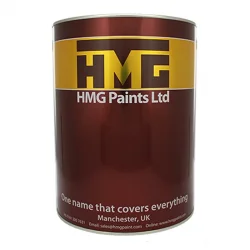
HMG Stoving Enamel Hammer Finish
HMG Stoving Enamel Hammer Finish is a high performance, rapid curing, high build, general purpose stoving enamel with a textured, hammer finish. Combines excellent colour and gloss retention together with good physical properties Suitable for most domestic and industrial applications Offers fast production turn around combined with...
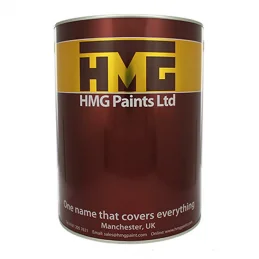
HMG Hammer Finish QAD
HMG Hammer Finishes QAD are used to produce an attractive and durable special effect hammer finish, which will hide imperfections on marked, pitted, or uneven surfaces of all types. Excellent drying gloss, adhesion and weathering properties Available in a range of colours with an attractive hammer finish For application on a wide variety...
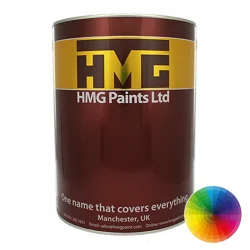
HMG Stoving Enamel
HMG Stoving Enamel is a high performance, rapid curing, high build, general purpose stoving enamel. Stoving paints are for force-drying; for painting stoves, see our heat-resistant paints Combines excellent colour and gloss retention together with good physical properties. Suitable for most domestic and industrial applications. Offers...
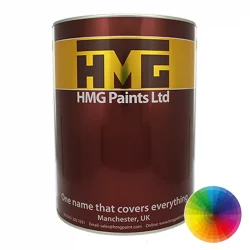
HMG Acrylic Stoving Enamel
HMG Acrylic Stoving Enamel is a durable and easy to use fast curing stoving enamel that is designed to give optimum durability and excellent colour retention on exterior exposure. Stoving paints are for force-drying; for painting stoves, see our heat-resistant paints. Ease of use Good long term durability High gloss Available in 3,500...
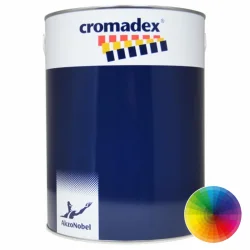
Cromadex 943 Acrylic Stoving Topcoat
Cromadex 943 Acrylic Stoving Topcoat is a stoving topcoat with direct metal adhesion, helping to reduce application costs. It has good exterior durability making it suitable for many applications. 5,000+ colours, inc. RAL, RAL Design & Effect, BS, NCS & NCS 2050 including RAL Metallic and Cromadex Metallic Shades* *Please note:...
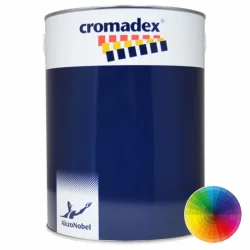
Cromadex 942 Medium Texture Stoving Topcoat
Cromadex 942 Medium Texture Stoving Topcoat is a stoving topcoat that comes in a medium texture finish that adds value to your article. The choice of stoving schedules enables production flexibility. The mar resistance of Cromadex 942 makes it suitable in tough environments. 5,000+ colours, inc. RAL, RAL Design & Effect, BS, NCS &...
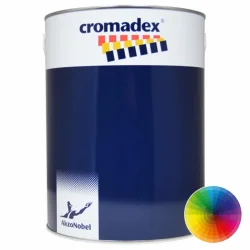
Cromadex 940 Fine Texture Stoving Topcoat
Cromadex 940 Fine Texture Stoving Topcoat is a stoving topcoat that comes in a fine texture finish that adds value to your article. The choice of stoving schedules enables production flexibility. The mar resistance of Cromadex 940 makes it suitable in tough environments. 5,000+ colours, inc. RAL, RAL Design & Effect, BS, NCS & NCS...
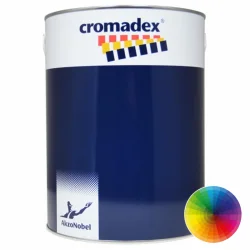
Cromadex 310 Low Bake Stoving Topcoat
Cromadex 310 Low Bake Stoving Topcoat is a low bake stoving topcoat that contains melamine to give it a tough durable finish. The lower stoving schedule of the product can help in reducing overall heating costs. The unique resin and pigment technology used enables both a wide variety of applications and a durable finish. 5,000+ colours,...
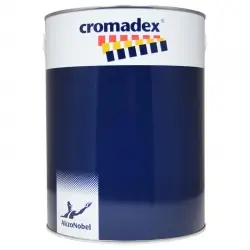
Cromadex 230 Stoving Primer Filler
Cromadex 230 Stoving Primer Filler is a stoving primer filler containing melamine giving improved durability. The product can be overcoated wet-on-wet enabling rapid application. Cromadex 230 Stoving Primer Filler is available in white as standard, it can also be tinted to ensure complete coverage even on difficult lead free colours. Stoving...
Need Help?
Need Help?
Stoving paints, also known as baking enamels, are a vital coating solution in industries requiring force drying through heat-curing processes. Unlike conventional paints that rely on air drying, stoving paints are applied and then heated at elevated temperatures to initiate a chemical cross-linking process that hardens the coating. This method ensures a durable, chemically resistant finish that is ideal for various industrial and commercial applications, particularly in sectors where components are exposed to demanding environments.
The heat-curing process not only accelerates the drying time but also enhances the paint’s overall performance. Once cured, these coatings exhibit superior resistance to corrosion, abrasions, and chemical exposure. These qualities make stoving paints an invaluable solution for applications where long-term durability is essential, such as automotive manufacturing, appliance production, and industrial equipment coatings.
Stoving paints are typically applied to metal substrates, although they can be formulated for use on other materials. This category of paint is available in various finishes, including glossy, matte, and textured options, depending on the specific requirements of the application. The versatility of stoving paints in terms of finish, chemical resistance, and adhesion properties makes them a preferred choice in many high-performance industrial coatings.
Top Features and Benefits of Stoving Paints
When selecting a stoving paint, several critical features should be considered to ensure the best match for the intended application. These features directly translate into benefits, making stoving paints a highly valued product in industrial sectors. Here are the most important aspects to consider:
Durability
Stoving paints offer an exceptionally hard finish after heat curing. This durable surface withstands harsh environmental conditions and is resistant to abrasions, making it suitable for parts subjected to regular wear and tear.
Chemical Resistance
These coatings provide excellent protection against chemicals, oils, and solvents, ensuring that components maintain their integrity in chemically aggressive environments.
Corrosion Resistance
Once cured, stoving paints form a non-porous barrier that protects metal surfaces from rust and corrosion, a vital property for industries like automotive and marine.
High Adhesion
The heat-curing process promotes strong adhesion between the paint and the substrate, ensuring long-lasting performance, even under mechanical stress.
Thermal Stability
Stoving paints remain stable at high temperatures, ensuring that they do not degrade or lose their protective properties when exposed to heat.
Fast Curing
One of the significant advantages of stoving paints is the reduced curing time compared to air-dried paints. This feature increases productivity in industries that rely on efficient production lines.
Custom Finishes
Stoving paints come in a variety of finishes, from high gloss to matte and even hammered, providing both functional and aesthetic versatility for different applications.
Scratch and Impact Resistance
The hardness of the cured paint layer offers excellent resistance to scratches, impacts, and mechanical damage, reducing maintenance requirements.
Stoving Paints and DIY Applications: Why They Are Not Suitable for Stoves
For DIY enthusiasts exploring paint solutions for heat-exposed items, it is important to understand that despite their name, stoving paints are not designed for painting stoves. The term ‘stoving’ refers to the paint’s curing process, which involves baking the coated item in a controlled industrial oven at temperatures usually between 120-200°C. This curing process solidifies the paint and enhances its protective qualities. However, household stoves reach much higher temperatures than what is used in the stoving process. As a result, stoving paints are not formulated to withstand direct flame or extreme heat, making them unsuitable for use on surfaces like stove exteriors or fireplaces.
For DIY projects involving heat-resistant coatings, other specialised heat-resistant paints should be considered. These alternatives are specifically formulated to endure the higher temperatures associated with stoves, fireplaces, or outdoor grills. In contrast, stoving paints are best reserved for industrial or commercial projects where heat curing can be tightly controlled and optimised for the paint’s chemical structure.
Example Uses of Stoving Paints
Stoving paints play a crucial role in multiple industries where components and surfaces require heat curing for a tough, resilient finish. Their versatility and durability make them indispensable in applications where high performance, chemical resistance, and surface protection are paramount. Below is an expanded exploration of the common uses of stoving paints, providing additional context and examples to illustrate their importance in various sectors.
Automotive Industry
Stoving paints are a cornerstone in the automotive industry, where they are used extensively on vehicle bodies, engine components, and other high-performance parts. Vehicles are subject to extreme conditions, including exposure to moisture, salt, heat, and mechanical impacts, making it essential that coatings provide both protection and longevity.
Vehicle Body Coatings
In automotive manufacturing, the exterior of cars, trucks, and motorcycles is often treated with stoving paints to create a hard, glossy finish that can endure harsh environmental conditions. The ability of stoving paints to resist corrosion from road salt, chemicals, and moisture makes them ideal for this application. Additionally, the customisable finish allows manufacturers to meet both functional and visual requirements, offering a wide range of colours and textures to enhance the vehicle’s appearance while protecting it from rust and environmental wear.
Engine Components
Engine parts are exposed to high levels of heat and require coatings that can withstand these temperatures without degrading. Stoving paints offer the thermal stability necessary to protect engine components such as cylinder heads, manifolds, and valve covers from heat-induced damage and corrosion. These coatings help prolong the life of the engine by providing a protective barrier against oils, fuels, and other fluids.
Underbody Protection
The underside of a vehicle is constantly exposed to debris, water, and salt, especially in colder climates where road salt is used to prevent ice formation. Stoving paints applied to the underbody, including suspension components and chassis parts, provide an additional layer of protection against rust and mechanical damage, ensuring the vehicle’s structural integrity is maintained over time.
Motorcycle and Bicycle Frames
Stoving paints are also used on motorcycle and bicycle frames, providing a robust coating that resists scratches, corrosion, and exposure to the elements. This application is particularly important for outdoor vehicles, where metal surfaces are subject to constant wear from road conditions, rain, and UV exposure.
Appliance Manufacturing
Stoving paints are commonly applied to both domestic and industrial appliances, offering a durable, aesthetically pleasing finish that resists everyday wear and tear.
Washing Machines and Dishwashers
Stoving paints are used to coat the metal exteriors of washing machines, dishwashers, and dryers, protecting them from rust and corrosion caused by moisture exposure. The protective layer also helps the appliance resist impact damage from bumps or knocks in busy households or industrial laundries. In addition to durability, these coatings provide a clean, smooth surface that is easy to wipe down and maintain.
Refrigerators
The exterior panels of refrigerators are often coated with stoving paints to ensure a long-lasting, smooth finish. Refrigerators are exposed to varying temperatures, moisture, and kitchen-related wear, making a tough, resilient coating essential for protecting the appliance from rust and surface damage. The coating's thermal stability ensures that it holds up well to frequent temperature changes, such as those caused by opening and closing the fridge door repeatedly throughout the day.
Ovens and Microwaves
Stoving paints can also be used on certain parts of ovens and microwaves, particularly those that do not come into direct contact with food. For example, oven handles, control panels, and exterior panels benefit from stoving paints, which offer a heat-resistant, scratch-proof finish that remains stable under the moderate temperatures these appliances generate.
Industrial Equipment
Heavy-duty industrial machinery often operates in harsh environments, requiring durable coatings that can protect against corrosion, mechanical wear, and exposure to chemicals or oils. Stoving paints provide a long-lasting solution for protecting these valuable machines.
Construction Equipment
Stoving paints are applied to the metal parts of construction equipment such as excavators, cranes, bulldozers, and forklifts. These machines are regularly exposed to dirt, dust, rain, and varying temperatures, necessitating a coating that provides resistance to rust, corrosion, and mechanical impact. By protecting these machines from environmental degradation, stoving paints help reduce maintenance costs and extend the life of the equipment.
Agricultural Machinery
In agriculture, tractors, harvesters, and ploughing equipment are exposed to soil, moisture, and a variety of chemicals, including fertilisers and pesticides. Stoving paints are ideal for coating these machines, as they offer protection from the corrosive effects of such chemicals. Additionally, the hard-wearing nature of the paint prevents damage from abrasions and impacts, which are common in farming operations.
Manufacturing Machinery
Industrial machines in factories, such as conveyors, mixers, and cutting tools, require coatings that can withstand constant use, mechanical stress, and exposure to oils and lubricants. Stoving paints provide a durable, corrosion-resistant layer that helps machinery stay in optimal working condition for longer periods, reducing the need for frequent repairs and replacements.
Marine and Offshore Applications
The marine environment is particularly challenging due to constant exposure to saltwater, which can accelerate corrosion in unprotected metals. Stoving paints are frequently used in this sector to provide a strong, impermeable layer that shields components from moisture and corrosive elements.
Ship Components
Stoving paints are applied to various ship parts, including hulls, decks, and structural elements. The coating provides a protective barrier against the corrosive effects of saltwater, humidity, and exposure to UV light. This is especially critical for ships that operate in saltwater environments, as unprotected metal surfaces can rapidly degrade and compromise the vessel’s safety.
Offshore Platforms
Offshore oil rigs and other marine structures require highly durable coatings to protect against the extreme conditions of the ocean. Stoving paints provide excellent corrosion resistance and withstand the continuous exposure to saltwater, wind, and temperature fluctuations. These coatings are critical for extending the lifespan of offshore platforms, reducing the need for frequent maintenance and preventing costly downtime.
Boating Equipment
Smaller watercraft, such as yachts, fishing boats, and dinghies, also benefit from the protection offered by stoving paints. These coatings are used on various metal components, including masts, hulls, and mechanical parts, to prevent rust and corrosion in environments where constant contact with water is inevitable.
Consumer Electronics
Many consumer electronic devices feature metal components that require protective coatings to enhance durability and provide a sleek, professional finish. Stoving paints play a key role in ensuring these devices can withstand daily use while maintaining their appearance.
Laptop Casings
Laptops with metal exteriors often use stoving paints to provide a scratch-resistant, durable finish that protects the device from damage during transport and everyday handling. The smooth, glossy finish also enhances the overall look of the laptop, contributing to its appeal to consumers.
Mobile Phones
The metal frames and casings of mobile phones are coated with stoving paints to protect them from scratches, impacts, and corrosion. As mobile phones are frequently exposed to moisture, heat, and mechanical stress, stoving paints provide the necessary durability and protection to ensure the device's longevity.
Household Gadgets
Small household appliances, such as toasters, blenders, and coffee machines, also use stoving paints on their metal components. These coatings help protect the appliances from rust, scratches, and heat damage, particularly in kitchen environments where moisture and heat are prevalent.
Furniture and Home Decor
Though stoving paints are primarily associated with industrial and automotive applications, they are increasingly being used in the production of metal furniture and home decor items. The appeal of a durable, long-lasting finish, combined with the availability of various textures and colours, makes stoving paints an excellent choice for these products.
Metal Chairs and Tables
In outdoor settings, metal chairs and tables are often coated with stoving paints to provide protection against rust and weathering. The hard, durable finish resists chipping and corrosion, ensuring that outdoor furniture remains in good condition even when exposed to rain and UV light.
Light Fixtures and Decorative Items
Metal light fixtures, wall art, and other decorative elements are frequently coated with stoving paints to achieve a polished, smooth finish. These items benefit from the paint’s ability to resist scratches and tarnishing, allowing them to maintain their appearance over time.
Cabinet Hardware
Handles, knobs, and other metal hardware used on cabinets and doors can be coated with stoving paints to provide a robust, attractive finish. This is particularly useful in kitchens and bathrooms, where moisture exposure can cause untreated metal to corrode.
Stoving paints offer unmatched durability, corrosion resistance, and aesthetic versatility, making them suitable for a wide range of industrial and consumer applications. Their ability to withstand harsh environmental conditions, combined with a fast curing process, ensures that these coatings meet the demanding requirements of multiple sectors. For assistance in selecting the appropriate stoving paint or for further details on product compatibility, contact the technical support team at Rawlins Paints.
FAQs
- Can stoving paints be applied to any surface? Stoving paints are primarily formulated for metal surfaces, particularly those used in industrial and automotive applications. They can also be applied to certain plastics, provided the material can endure the heat-curing process. However, they are not suitable for materials like wood or fabrics.
- What temperature is required to cure stoving paints? The curing process for stoving paints typically occurs at temperatures ranging from 120°C to 200°C. The exact temperature depends on the specific formulation of the paint and the material being coated.
- Are stoving paints suitable for outdoor applications? Yes, stoving paints are highly suitable for outdoor applications, particularly in environments where components are exposed to moisture, chemicals, and UV light. Their durable, corrosion-resistant properties make them ideal for outdoor industrial equipment, vehicles, and marine applications.
- Can stoving paints be used in food preparation areas? Stoving paints can be used in environments where incidental food contact might occur, but it is crucial to check if the specific paint is food-safe. Consult the manufacturer’s specifications for any restrictions related to food safety.
- What is the typical drying time for stoving paints? The drying time of stoving paints depends on the curing temperature. At 120-200°C, curing usually occurs within 15 to 60 minutes, after which the paint reaches its final hardness.
- How does stoving paint differ from regular air-drying paints? Stoving paints require heat curing to achieve their final hardness and durability, whereas air-drying paints rely on evaporation over time. Stoving paints provide superior resistance to abrasion, chemicals, and corrosion, making them ideal for high-performance applications.
- Can stoving paints be overcoated? Yes, stoving paints can be overcoated with another layer of paint if needed. It is essential to ensure that the base layer has fully cured before applying any additional coatings.
- Are stoving paints environmentally friendly? Many stoving paints are formulated to be solvent-based, which may raise concerns about volatile organic compounds (VOCs). However, there are low-VOC options available for those seeking more environmentally friendly solutions.
- What is the best way to apply stoving paints? Stoving paints are usually applied using spray techniques, as this allows for an even and consistent coat. Brushing or rolling may be used in some cases, but spray application is generally preferred for industrial finishes.
- Can stoving paints be removed or repaired? Repairing stoving paints can be challenging due to their hard, durable finish. Small scratches or chips may be repaired with touch-up applications, but larger areas may require stripping and recoating to ensure a consistent finish.
